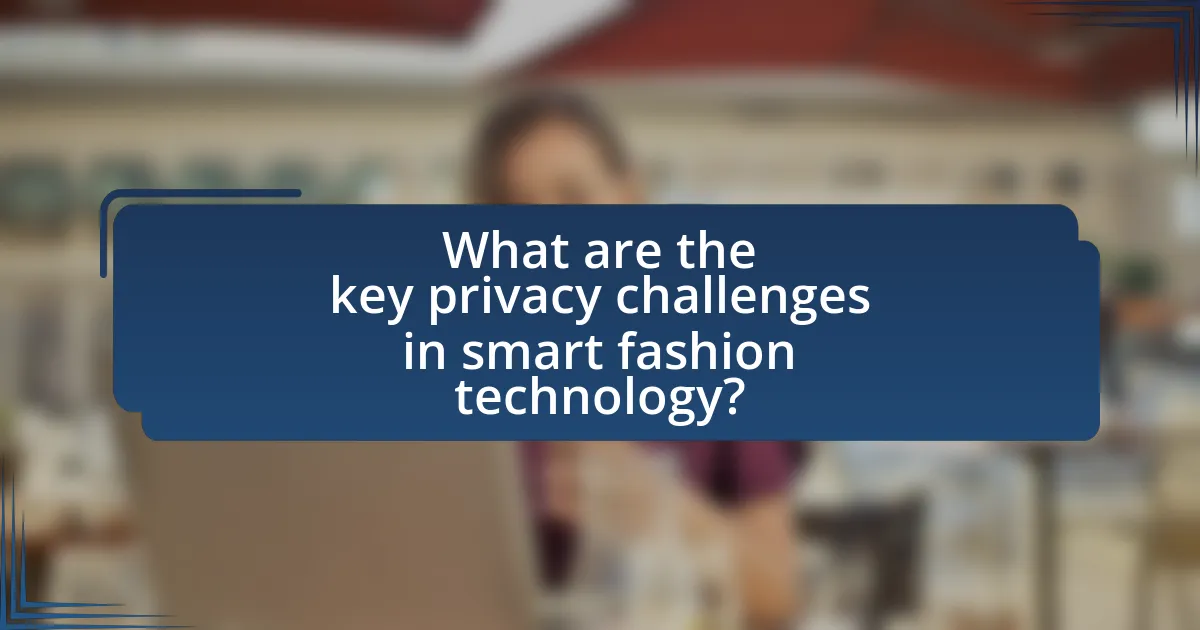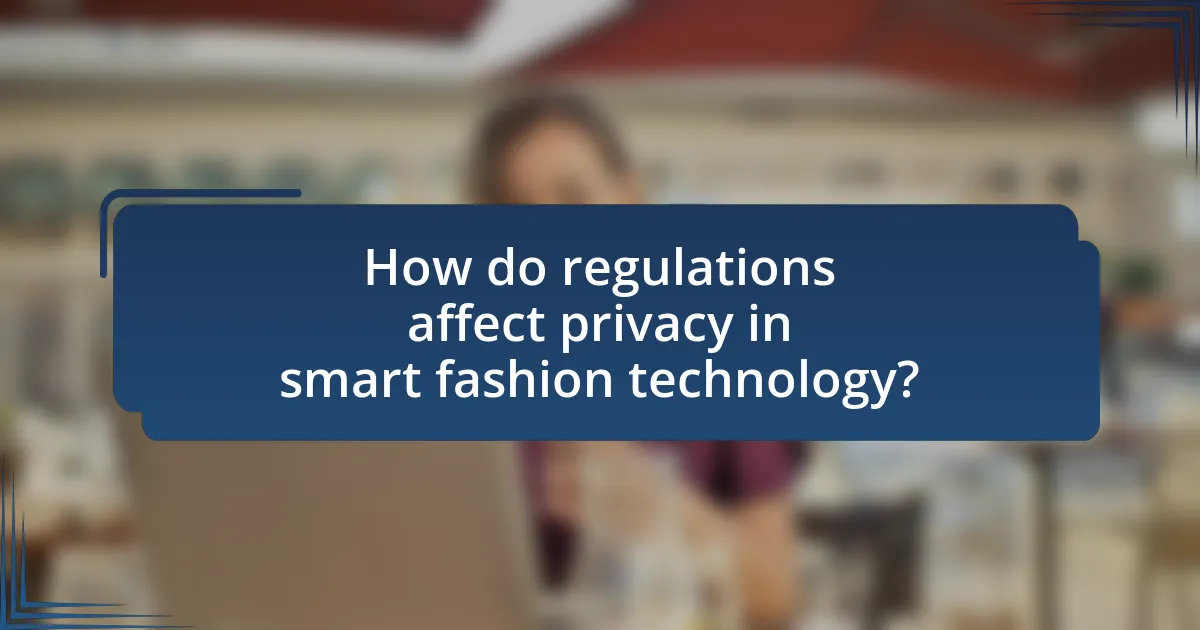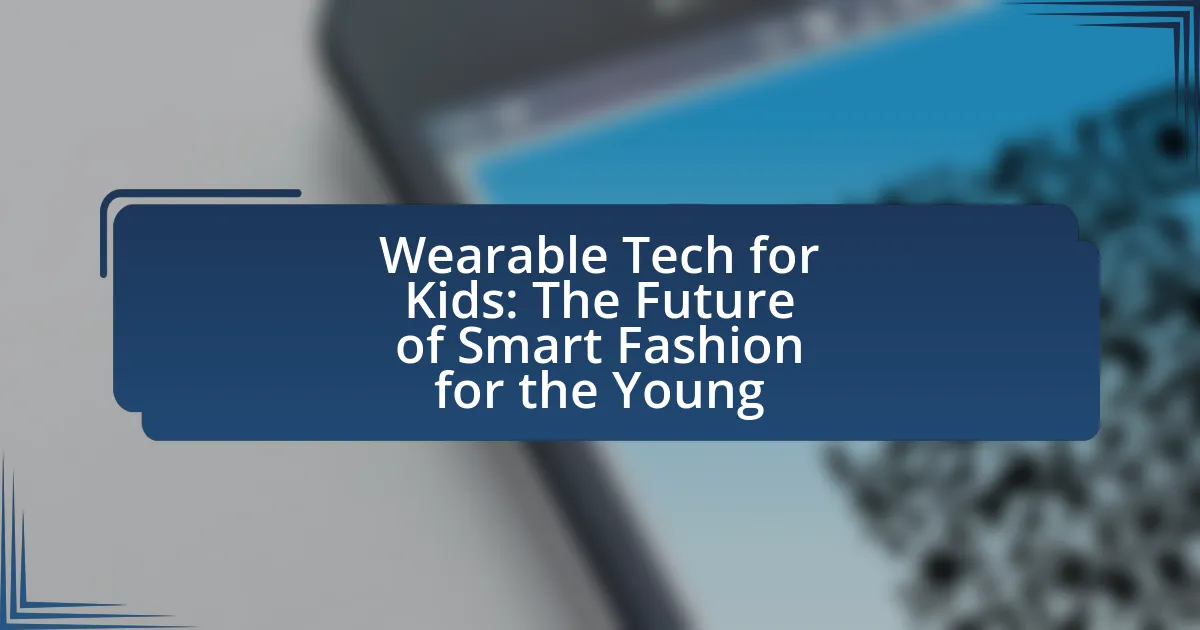The article focuses on the privacy challenges associated with smart fashion technology, highlighting key issues such as data security, user consent, and surveillance concerns. It examines the types of data collected by smart fashion devices, the implications of data breaches, and the importance of user awareness in protecting personal information. Additionally, the article discusses the role of regulations like the GDPR and CCPA in shaping privacy practices, as well as the impact of emerging technologies on privacy concerns. Practical steps for consumers to safeguard their privacy and evaluate brand policies are also outlined, emphasizing the need for robust data protection measures in the evolving landscape of smart fashion.

What are the key privacy challenges in smart fashion technology?
The key privacy challenges in smart fashion technology include data security, user consent, and surveillance concerns. Smart fashion devices often collect sensitive personal data, such as biometric information and location tracking, which can be vulnerable to breaches if not properly secured. Additionally, obtaining informed consent from users regarding data collection and usage is complex, as many consumers may not fully understand the implications of sharing their information. Furthermore, the potential for constant surveillance through connected clothing raises ethical questions about privacy rights and individual autonomy. These challenges highlight the need for robust privacy frameworks and regulations to protect consumers in the evolving landscape of smart fashion technology.
How does data collection impact user privacy in smart fashion?
Data collection in smart fashion significantly impacts user privacy by enabling the tracking of personal information and behaviors. Smart clothing and wearable devices often gather data such as body measurements, health metrics, and location, which can be sensitive and personally identifiable. For instance, a study by the International Journal of Information Management found that 70% of consumers expressed concerns about how their data is used by fashion brands, highlighting the potential for misuse or unauthorized access to personal information. This data can be exploited for targeted advertising or sold to third parties without user consent, further compromising individual privacy.
What types of data are collected by smart fashion devices?
Smart fashion devices collect various types of data, including biometric data, usage patterns, environmental data, and personal preferences. Biometric data encompasses information such as heart rate, body temperature, and movement, which are gathered through sensors embedded in clothing. Usage patterns track how often and in what contexts the garments are worn, providing insights into consumer behavior. Environmental data includes factors like temperature and humidity, which can influence the performance of the clothing. Personal preferences are derived from user interactions with the device, such as style choices and fit adjustments. These data types raise significant privacy concerns, as they can reveal sensitive information about individuals’ health and lifestyle.
How is user consent obtained for data collection?
User consent for data collection is obtained through clear and transparent communication of data practices. Organizations typically present users with consent forms or notices that outline what data will be collected, how it will be used, and the implications of consent. This process often includes options for users to agree or decline, ensuring that consent is informed and voluntary. For example, the General Data Protection Regulation (GDPR) mandates that consent must be explicit and can be withdrawn at any time, reinforcing the importance of user autonomy in data collection practices.
What are the risks associated with data breaches in smart fashion?
Data breaches in smart fashion pose significant risks, including identity theft, financial loss, and reputational damage. The integration of technology in clothing often involves the collection of personal data, such as biometric information and purchasing habits. When this data is compromised, individuals may face unauthorized access to their financial accounts or personal identities, leading to potential fraud. A report by IBM Security indicates that the average cost of a data breach in 2021 was $4.24 million, highlighting the financial implications for companies involved in smart fashion. Additionally, brands may suffer long-term reputational harm, as consumers lose trust in their ability to protect sensitive information.
What are the potential consequences of a data breach for users?
A data breach can lead to severe consequences for users, including identity theft, financial loss, and privacy violations. When personal information such as names, addresses, and financial details is exposed, malicious actors can exploit this data to impersonate users, leading to unauthorized transactions and significant financial damage. According to a 2020 report by the Identity Theft Resource Center, over 1.1 million cases of identity theft were reported in the United States alone, highlighting the real risk users face following a data breach. Additionally, users may experience emotional distress and loss of trust in the affected company, which can further impact their willingness to engage with similar technologies in the future.
How can companies mitigate the risks of data breaches?
Companies can mitigate the risks of data breaches by implementing robust cybersecurity measures, including encryption, regular security audits, and employee training. Encryption protects sensitive data by making it unreadable to unauthorized users, while regular security audits help identify vulnerabilities in systems. Employee training ensures that staff are aware of security protocols and phishing threats, reducing the likelihood of human error, which is a significant factor in data breaches. According to the 2021 Verizon Data Breach Investigations Report, 85% of breaches involved a human element, highlighting the importance of comprehensive training and awareness programs.
Why is user awareness important in smart fashion technology?
User awareness is crucial in smart fashion technology because it empowers individuals to make informed decisions regarding their privacy and data security. As smart fashion integrates wearable technology that collects personal data, users must understand how their information is used, shared, and protected. Research indicates that a lack of awareness can lead to unintentional data exposure, as seen in a study by the International Journal of Information Management, which found that 60% of users did not know how their wearable devices collected and transmitted data. This highlights the necessity for user education to mitigate risks associated with privacy breaches and to foster responsible usage of smart fashion products.
How can users protect their privacy when using smart fashion devices?
Users can protect their privacy when using smart fashion devices by implementing strong security measures, such as using unique, complex passwords and enabling two-factor authentication. These practices significantly reduce the risk of unauthorized access to personal data. Additionally, users should regularly update the device firmware and software to patch vulnerabilities, as outdated systems are more susceptible to breaches. Research indicates that 60% of data breaches occur due to weak passwords, highlighting the importance of robust security practices. Furthermore, users should review and adjust privacy settings on their devices and associated apps to limit data sharing and tracking. By being proactive in these areas, users can effectively safeguard their personal information while enjoying the benefits of smart fashion technology.
What role does education play in enhancing user privacy awareness?
Education plays a crucial role in enhancing user privacy awareness by equipping individuals with the knowledge and skills necessary to understand and navigate privacy issues. Through educational programs, users learn about data protection laws, the implications of data sharing, and the importance of personal information security. For instance, studies have shown that individuals who receive training on privacy practices are more likely to adopt secure behaviors online, such as using strong passwords and being cautious about sharing personal information. This correlation is supported by research from the Pew Research Center, which found that 80% of Americans feel they have little control over their personal information online, highlighting the need for educational initiatives to empower users.

How do regulations affect privacy in smart fashion technology?
Regulations significantly impact privacy in smart fashion technology by establishing legal frameworks that dictate how personal data is collected, stored, and used. For instance, the General Data Protection Regulation (GDPR) in the European Union mandates that companies must obtain explicit consent from users before processing their personal data, which directly influences how smart fashion brands design their data collection practices. Compliance with such regulations often requires companies to implement robust data protection measures, thereby enhancing user privacy. Additionally, regulations can impose penalties for non-compliance, incentivizing companies to prioritize privacy in their technological innovations.
What are the current regulations governing data privacy in fashion tech?
Current regulations governing data privacy in fashion tech primarily include the General Data Protection Regulation (GDPR) in the European Union and the California Consumer Privacy Act (CCPA) in the United States. GDPR mandates strict guidelines on data collection, processing, and storage, requiring companies to obtain explicit consent from users and allowing individuals to access and delete their personal data. CCPA enhances consumer rights by granting California residents the ability to know what personal data is collected, the right to delete that data, and the right to opt-out of its sale. These regulations are crucial as they address the unique challenges of data privacy in the fashion tech sector, where personal data is often collected through wearable technology and online shopping platforms.
How do these regulations vary across different regions?
Regulations regarding privacy in smart fashion technology vary significantly across different regions due to differing legal frameworks and cultural attitudes towards data protection. For instance, the European Union enforces the General Data Protection Regulation (GDPR), which mandates strict consent requirements and data protection measures for personal data processing. In contrast, the United States lacks a comprehensive federal privacy law, leading to a patchwork of state laws, such as the California Consumer Privacy Act (CCPA), which provides some consumer rights but is less stringent than GDPR. Additionally, countries like China have implemented the Personal Information Protection Law (PIPL), which emphasizes data localization and user consent but operates within a broader context of state surveillance. These variations highlight the complexities businesses face when navigating privacy regulations in the global smart fashion market.
What challenges do companies face in complying with these regulations?
Companies face significant challenges in complying with privacy regulations in smart fashion technology, primarily due to the complexity of data management and the evolving nature of legal requirements. The integration of advanced technologies, such as IoT devices and AI, generates vast amounts of personal data, making it difficult for companies to ensure proper data handling and protection. Additionally, the lack of standardized regulations across different jurisdictions complicates compliance efforts, as companies must navigate varying legal frameworks. For instance, the General Data Protection Regulation (GDPR) in Europe imposes strict guidelines that may differ from regulations in other regions, leading to potential legal risks and financial penalties for non-compliance. Furthermore, companies often struggle with implementing adequate security measures and training employees on compliance protocols, which can result in data breaches and loss of consumer trust.
How can companies ensure compliance with privacy regulations?
Companies can ensure compliance with privacy regulations by implementing robust data protection policies and practices. This includes conducting regular audits to assess data handling processes, training employees on privacy laws, and utilizing privacy-by-design principles in product development. For instance, the General Data Protection Regulation (GDPR) mandates that organizations must demonstrate accountability and transparency in their data processing activities, which can be achieved through documentation and clear consent mechanisms. Additionally, companies should stay updated on evolving regulations and engage with legal experts to navigate complex compliance landscapes effectively.
What best practices should companies adopt for data protection?
Companies should adopt a multi-layered approach to data protection that includes encryption, access controls, regular audits, and employee training. Implementing encryption ensures that sensitive data is unreadable to unauthorized users, while access controls limit data access to only those who need it for their roles. Regular audits help identify vulnerabilities and ensure compliance with data protection regulations, such as the General Data Protection Regulation (GDPR), which mandates strict data handling practices. Furthermore, training employees on data protection policies and phishing awareness reduces the risk of human error, which is a significant factor in data breaches. According to a report by IBM, human error is a contributing factor in 95% of cybersecurity incidents, highlighting the importance of comprehensive training programs.
How can companies balance innovation with privacy compliance?
Companies can balance innovation with privacy compliance by integrating privacy-by-design principles into their product development processes. This approach ensures that privacy considerations are embedded from the outset, allowing for innovative solutions that respect user data. For instance, the General Data Protection Regulation (GDPR) mandates that organizations implement data protection measures during the design phase of new technologies, which encourages companies to innovate within a compliant framework. Research shows that organizations adopting privacy-by-design not only enhance user trust but also reduce the risk of costly data breaches, thereby fostering a sustainable innovation environment.

What future trends may impact privacy in smart fashion technology?
Future trends that may impact privacy in smart fashion technology include the increasing integration of artificial intelligence and the Internet of Things (IoT) into wearable devices. As smart clothing becomes more sophisticated, it will collect and analyze vast amounts of personal data, raising concerns about data security and user consent. For instance, a report by McKinsey & Company highlights that the global smart clothing market is expected to reach $5 billion by 2025, indicating a significant rise in data collection capabilities. Additionally, advancements in biometric sensors may lead to more personalized experiences but also increase the risk of sensitive information being misused. These trends underscore the need for robust privacy regulations and transparent data handling practices in the smart fashion industry.
How is the evolution of technology influencing privacy concerns?
The evolution of technology is significantly increasing privacy concerns by enabling extensive data collection and surveillance capabilities. As smart fashion technology integrates sensors and connectivity, it collects personal data such as biometric information, location, and user preferences. For instance, a study by the International Data Corporation (IDC) reported that the global market for wearable devices is expected to reach $100 billion by 2024, highlighting the proliferation of devices that can track personal information. This widespread data collection raises issues regarding consent, data security, and the potential for misuse, as individuals often lack control over how their data is used and shared. Consequently, the advancement of technology in smart fashion amplifies the risks associated with personal privacy, necessitating stronger regulations and awareness among consumers.
What emerging technologies pose new privacy challenges?
Emerging technologies that pose new privacy challenges include artificial intelligence, the Internet of Things (IoT), and blockchain. Artificial intelligence systems can analyze vast amounts of personal data, leading to potential misuse or unauthorized access to sensitive information. The IoT connects numerous devices that collect and transmit personal data, increasing the risk of data breaches and surveillance. Blockchain, while offering secure transactions, can also inadvertently expose user identities and transaction histories if not properly managed. These technologies highlight the need for robust privacy protections as they evolve and integrate into daily life.
How can companies adapt to these evolving privacy challenges?
Companies can adapt to evolving privacy challenges by implementing robust data protection strategies and ensuring compliance with privacy regulations. This includes adopting privacy-by-design principles, which integrate data protection into the development process of smart fashion technologies. Additionally, companies should conduct regular privacy impact assessments to identify and mitigate risks associated with data collection and usage.
For instance, the General Data Protection Regulation (GDPR) mandates that organizations must demonstrate accountability and transparency in their data handling practices. By adhering to such regulations, companies not only protect consumer data but also build trust with their customers. Furthermore, investing in employee training on data privacy and security can enhance awareness and reduce the likelihood of data breaches.
Research indicates that organizations prioritizing privacy can gain a competitive advantage, as consumers increasingly prefer brands that respect their privacy. Thus, a proactive approach to privacy challenges can lead to improved customer loyalty and brand reputation.
What role will consumer demand play in shaping privacy practices?
Consumer demand will significantly influence the development of privacy practices in smart fashion technology. As consumers increasingly prioritize data protection and privacy, companies will adapt their practices to meet these expectations. For instance, a 2021 survey by the International Association of Privacy Professionals found that 79% of consumers are concerned about how their personal data is used, prompting brands to implement stricter privacy measures to maintain customer trust and loyalty. This shift in consumer behavior drives companies to enhance transparency, adopt privacy-by-design principles, and comply with regulations, ultimately shaping the landscape of privacy practices in the industry.
How can companies respond to consumer concerns about privacy?
Companies can respond to consumer concerns about privacy by implementing transparent data practices and enhancing security measures. Transparency involves clearly communicating how consumer data is collected, used, and shared, which builds trust. For instance, a survey by the Pew Research Center found that 79% of Americans are concerned about how their data is being used by companies, highlighting the need for clear privacy policies. Additionally, companies can adopt robust security protocols, such as encryption and regular security audits, to protect consumer data from breaches. According to a report by IBM, organizations that prioritize data security can reduce the cost of data breaches by an average of $1.76 million, demonstrating the financial benefits of addressing privacy concerns effectively.
What trends in consumer behavior are influencing privacy policies?
Trends in consumer behavior influencing privacy policies include increasing demand for transparency, heightened awareness of data security, and a preference for personalized experiences. Consumers are now more informed about how their data is collected and used, leading to a push for brands to disclose their data practices clearly. According to a 2022 survey by the International Association of Privacy Professionals, 79% of consumers expressed concern about how their personal information is handled, prompting companies to adopt stricter privacy measures. Additionally, the rise of data breaches has made consumers more cautious, driving them to favor businesses that prioritize robust data protection. This shift in behavior is compelling organizations to revise their privacy policies to align with consumer expectations and regulatory requirements.
What practical steps can consumers take to protect their privacy in smart fashion technology?
Consumers can protect their privacy in smart fashion technology by taking several practical steps. First, they should carefully review the privacy policies of smart clothing and wearable devices before purchase, ensuring they understand how their data will be collected, used, and shared. Additionally, consumers should opt for products that offer robust data encryption and security features, as these can significantly reduce the risk of unauthorized access to personal information.
Furthermore, consumers should regularly update the software and firmware of their devices to protect against vulnerabilities, as manufacturers often release updates to address security flaws. It is also advisable to limit the amount of personal information shared with apps associated with smart fashion technology, only providing what is necessary for functionality.
Lastly, consumers can utilize privacy settings on their devices and apps to control data sharing preferences, ensuring they are only sharing information they are comfortable with. These steps are essential in mitigating privacy risks associated with smart fashion technology, as evidenced by studies indicating that data breaches often occur due to inadequate user awareness and security practices.
How can consumers evaluate the privacy policies of smart fashion brands?
Consumers can evaluate the privacy policies of smart fashion brands by carefully reviewing the clarity, comprehensiveness, and transparency of the policies. A clear privacy policy should explicitly outline what personal data is collected, how it is used, and with whom it is shared. Comprehensive policies include details on data retention periods and user rights regarding their data. Transparency is demonstrated through straightforward language and easy access to the policy on the brand’s website. According to a 2021 survey by the International Association of Privacy Professionals, 79% of consumers are more likely to trust brands that provide clear and accessible privacy information. This statistic underscores the importance of evaluating privacy policies as a means of assessing brand trustworthiness in the context of smart fashion technology.
What tools and resources are available for consumers to enhance their privacy?
Consumers can enhance their privacy using tools such as virtual private networks (VPNs), privacy-focused web browsers like Brave, and encrypted messaging apps such as Signal. VPNs encrypt internet traffic, making it difficult for third parties to track online activities. Privacy-focused browsers block trackers and ads, while encrypted messaging apps ensure that communications remain confidential. Additionally, consumers can utilize password managers to create and store strong, unique passwords, reducing the risk of unauthorized access to their accounts. These tools collectively help safeguard personal information in the context of smart fashion technology, where data privacy is increasingly at risk.





